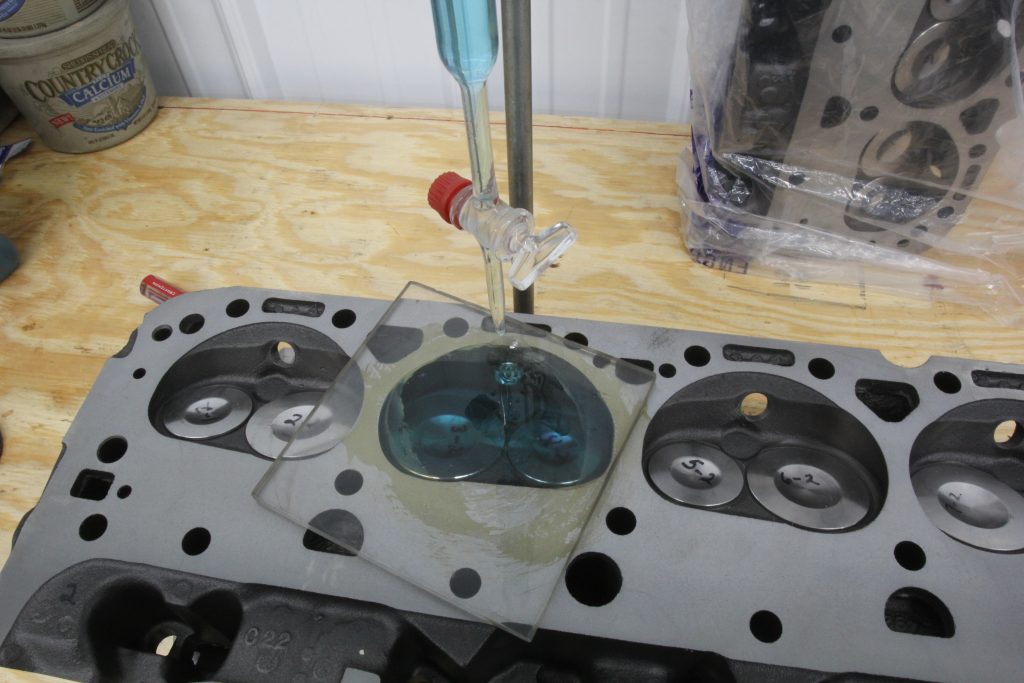My dad built this 383 small block Chevy probably 20 years ago. The heads are off the engine and it has domed pistons but I don’t know any details—like the piston manufacturer or the dome volume or anything like that. If I run a 72cc chamber, how can I figure out the compression ratio?
D.C.
Computing compression ratio isn’t difficult even with components where you do not have detailed information. In order to do this job you will need a few specific tools. The most important is a 100cc burette kit for measuring volume of both the combustion chamber and the piston in the cylinder.
In order to accomplish this task, you will need some specialized tools. The main one is a 100cc burette tube and mounting stand for the burette while you add fluid into the cylinder or the combustion chamber. You will also need a flat plexiglass plate lid to close the chamber and cylinder along with a small amount of grease to seal the plate to the chamber/block. Summit Racing offers several cylinder head CC kits along these lines or perhaps you have an engine builder friend who would be willing to loan you the tools or perform the job.
Measuring the Piston in the Bore
To start, what we need to do is measure the volume of the piston in the bore at a given height below the deck and compare this number to a calculated volume assuming a pre flat top piston. Let’s say that the dome measures roughly a half inch (0.450 inch) above the flat of the piston where you would measure the deck height relative to the block. This means we will have to pull the piston below the deck 0.500 inch to allow a flat plate to cover the bore.
First we will need some measurements. Let’s assume the bore is 4.030 and the stroke, is 3.75 inches. Next, we need to know the volume of this 4.030 inch cylinder with a pure flat top piston 0.500 inch below the deck. To calculate the volume of a cylinder we will use this formula*:
Volume = Bore x Bore X Height x 0.7854
* The real formula is Pi times radius squared. But we will use that shortcut above.
The answer will be in cubic inches that we will need to convert to cubic centimeters since that’s the metric volume we will use to calculate the compression ratio.
The conversion is 16.387cc = 1 cubic inch.
Volume = 4.030 x 4.030 x 0.7854 = 12.75 cubic inches
12.75 x 16.387 = 208.9cc’s – we’ll round that off to 209cc
This is the volume of the 383’s cylinder assuming a pure flat top piston. Now we need to place the piston in Number One cylinder at exactly 0.500 inch down from the block deck surface. You can seal the top ring with a tiny bit of grease to prevent leakage past the top ring gap.
Determining Combustion Chamber Volume
Next, we will use a flat plastic plate with a small holed drilled into it, sealed with a little bit of grease to cover the bore. Then we will fill the cylinder with our 100cc burette. It will require filling the burette twice to achieve over 200cc. Since the dome will take up a certain volume, the cylinder will be completely filled before emptying the second 100cc burette.
Let’s say that the burette produces a total volume of 194cc while our calculated volume without a dome is 209cc. Some simple subtraction offers: 209-194 = 15cc. This would be the volume of the piston dome.
When performing the measurement, we are also including the area just above the piston top ring which is called the clearance volume but it rarely is more than 1 or 2cc. So now we can take this dome volume of 15cc and use it to calculate the compression ratio.

Finding Piston Deck Height
You will also need to know the piston deck height, which is generally on small block Chevys a distance below the deck surface. For this example, let’s establish the piston 0.005 inch below the deck. Additional volumes we must use include the gasket thickness (0.042 inch) and of course the combustion chamber volume (72cc). The other two variables are the bore diameter of 4.030 and the stroke of 3.75 inches.
How to Calculate Engine Compression Ratio
Rather than run through the math involved with calculating compression ratio, we’re going to take the easy way out and use Summit Racing’s free compression ratio calculator, which can be found by clicking here.
Plugging all these numbers into the Summit Racing calculator, we find the static compression ratio would be 12.79:1. If the dome volume was smaller or the chamber was larger, the compression would be lower. Conversely if the dome was larger or chamber smaller, the compression would be higher.
Since you didn’t give us the rest of the details on your engine, our numbers are merely estimates—but at least you have the process now from which to determine the true static compression ratio of your engine.
Get details on the Proform Cylinder Head CC kit used in this article by clicking on the part number: PRO-66831

Comments